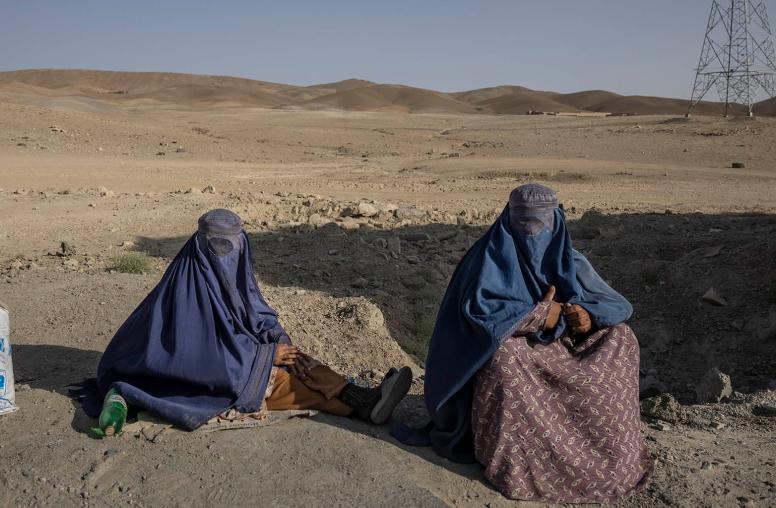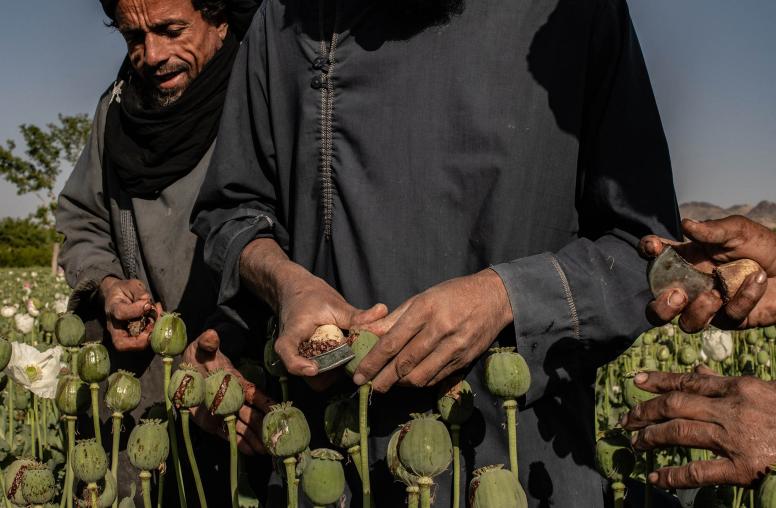Public Health and Conflict Series: Rebuilding a Nation's Health in Afghanistan
Since the Soviet invasion of 1979, Afghanistan's health system has been decimated by over 27 years of near constant conflict. What steps are necessary to ensure that quality health care is delivered to all of Afghanistan's citizens?
Since the Soviet invasion of 1979, Afghanistan's health system has been decimated by over 27 years of near constant conflict. The ensuing civil war between warlords and rebel groups, including the Taliban, led many Afghan doctors and other intellectuals to flee to Pakistan, Iran, and elsewhere. Under Taliban rule in the 1990s, women were forbidden to attend school, and university teaching hospitals had no equipment, no training materials, and few books.1 While there have been advances over the past five years through the assistance of United Nations organizations and the international NGO community, Afghanistan's health indicators remain among the lowest in the world.
On February 8, 2007, the United States Institute of Peace (USIP) and Johns Hopkins Bloomberg School of Public Health (JHSPH) Task Force on Public Health and Conflict held its second symposium, with Afghanistan as a case study. The Task Force is committed to raising the profile of conflict analysis and resolution in the field of public health education through a year-long series of events. Speakers at this symposium included Amin Tarzi, of Radio Liberty/Radio Free Europe; J. Alexander Thier, a senior Rule of Law adviser at USIP; JHSPH doctoral candidates Hamida Aman, Shivan Gupta, and Laura Steinhart; Abdullah Hanif, a graduate of Kabul Medical University; David Peters, associate professor at JHSPH; and Gilbert Burnham, the co-director of the Center for Refugee and Disaster Response at Johns Hopkins and a professor at JHSPH. This USIPeace Briefing summarizes the symposium's discussion on public health and conflict in Afghanistan. It was written by Sarah Dye, a research assistant in the Education program, and does not represent the views of the Institute, which does not take policy positions.
Reconstruction in Post-Conflict Afghanistan
Amin Tarzi, an Afghanistan analyst for Radio Liberty/Radio Free Europe, reported on the history and security of Afghanistan both before and after the United States' invasion in 2001. Tarzi described Afghanistan as the landlocked crossroads of three regions: the Middle East, Central Asia, and South Asia. Afghanistan's ethnic and cultural diversity reflect its long borders with Pakistan to the east and Iran to the west, and Turkmenistan, Uzbekistan, Tajikistan and China to the north. According to Tarzi, Afghanistan had just begun to mature as a unified country when conflict and chaos halted its development in 1979.
Tarzi suggested that the two reconstruction projects that need the most work in Afghanistan are health care and education, but he lamented that these are not "sexy" projects, and that it is difficult to get them the priority they deserve. Tarzi also reported that unless the narcotics issue is addressed and tackled, Afghanistan's security and health problems will persist. He warned that NATO will likely fail if it continues to neglect Afghanistan's narcotics issue. Tarzi reported that the issue seems intractable because from the perspective of Afghan farmers, there is no criminal association with the cultivation of opium, and no other crop is nearly as renumerative.
Tarzi highlighted the importance of understanding what he called the "Afghanistan Master Narrative." This is how Afghans perceive their own history. According to Tarzi, Afghans believe they have a 5,000 year-long shared history, which gives them a sense of grandeur and entitlement. The past 27 years of conflict, however, have shattered this grandeur and resulted in society that is "psychologically ill." By this, Tarzi means that Afghans have lost any sense of trust even among themselves, and that decades of upheaval have eliminated the feeling of collective responsibility. This has created an environment favorable to corruption and fostered a mindset focused on the short-term money grab. Because nobody thinks the current government will last, the prevailing attitude, according to Tarzi, is one of opportunism as foreign aid and development money pours into the country. Many people want to get enough to ensure their ability to leave and live in Europe rather than stay and rebuild the country.
J. Alexander Thier, senior Rule of Law advisor at USIP and former legal advisor to Afghanistan's constitutional and judicial reform commissions, spoke about the problems confronting the reconstruction process in Afghanistan today. Thier suggested that the U.S. presence in 2001-2002 was truly welcome in Afghanistan, that the Afghans were tired of devastation, and that they understood the need for outside intervention. But, Thier noted, foreign assistance has not been sufficiently tailored to meet the needs of the country. For example, the concept of a judicial system is "preposterous" in Afghanistan because 75-80 percent of the population live in villages in isolated valleys where conflicts are resolved face-to-face and not by government authorities. To these people, central government has historically meant oppression. Reconstruction efforts thus need to be approached as a generational project, and not as something that can be budgeted in a three-to-five year cycle.
Homaira Hanif, an Afghan-American and a graduate of JHSPH, noted that over the course of reconstruction efforts, there has been "a bit of Dubai coming into Kabul." He was referring to the inflow of private businessmen and foreign contractors who are building up the infrastructure in Kabul. Hanif suggested that this infrastructure usually takes the form of elaborate office buildings, which is not what Afghans need. Many returned Afghan refugees are living in rural areas with little resources, no running water, and poor sewage systems. According to Hanif, there is a general disillusionment with the foreign money coming in to the country because most Afghans are not experiencing positive changes in their own lives.
Health Care in Afghanistan
The 2006 United Nations Human Development Report for Afghanistan was abysmal. Although there is a problematic lack of data, the country consistently ranks among the lowest of the low in indicators for which data do exist. In Afghanistan, 39 percent of children under age five are underweight for their age; 48 percent of children under age five are under height for their age; 61 percent of the population is without sustainable access to an improved water source; and the under-five mortality rate is 257 per 1000 live births.2 These indicators, as well as those for life expectancy and GDP, place Afghanistan at the bottom of every sub-category compared to other countries in the region.
Abdullah Hanif, a medical doctor from Kabul, shared his practical and personal experience working in health care in Afghanistan. Hanif studied at Kabul Medical University, and worked with international NGOs providing health care in Kabul both before and after the U.S. invasion in 2001. Hanif reported that these NGOs tended to duplicate their Kabul services throughout the other provinces in which they were active rather than tailoring their programs to meet specific regional needs. Hanif also noted that most doctors he came in contact with focused on the curative rather than preventative side of medical care.
After 2002, the Afghanistan Ministry of Public Health (MPH) developed over sixty health care policies to enhance the reconstruction process. The most important of these are the Basic Package of Health Services (BPHS), which sets priorities for health care development, and the Essential Hospital Services, which developed a referral system between basic and comprehensive health services. There have been other significant developments after 2002, including a new attention to cost-effectiveness and sustainability, which Hanif partially attributed to the emerging local NGOs.
David Peters of JHSPH and members of his research team reported on their work to establish a "balanced scorecard" for health services in Afghanistan.3 After the Ministry of Public Health established its BPHS priorities, they needed a way to measure and monitor progress toward achieving the prioritized goals. Peters' team won the contract to work with MPH on evaluating the BPHS. Over the course of their research, some important positive developments emerged: community involvement in health services has been increasing over time; health workers' satisfaction indicators are rising; and each of the indicators for service provision demonstrate a trend of improvement.
Challenges to Improving Afghanistan's Health Services
Security is the main obstacle to enhancing health services in Afghanistan. Many provinces, especially in the south and west of the country, have not been reached by the BPHS nor have they been touched by other recent improvements in health services. Most of the skilled health workers who come to Afghanistan from neighboring countries leave almost immediately because the wages are so low. Low wages are also a disincentive to work in rural areas.
Homaira Hanif spoke about the lack of capacity in MPH. Infrastructure for delivering supplies and services, the quality of the staff, and the level of coordination with NGOs all require substantial investment. The brain drain that began in the 1980s has created a situation in which the best and the brightest working in health in Afghanistan tend to work for the NGOs and UN bodies, and not for MPH. Hanif described a Catch-22 situation in which donors are reluctant to provide funding to MPH if the capacity is not adequate, but MPH will have trouble building its capacity without any money to train its technical staff. Without an effective Ministry of Public Health, Afghanistan will continue to struggle to provide health services to its whole population. David Peters noted that NGOs are currently providing 80 percent of health services in Afghanistan, and that there is precious little communication and coordination between NGOs and the Ministry of Health.
Recommendations
Abdullah Hanif noted that there have been significant advances in skills and management training over recent years, for example in women's health issues, largely as a result of the BPHS. Many urban women's health practitioners are unwilling to relocate to rural areas because of the lower wages and security concerns. To ameliorate this, community midwifery education has provided accelerated learning to women living in rural areas through an 18-month program in midwifery skills. Training members of these rural communities in midwifery may have a substantial impact over the next few years on Afghanistan's high maternal mortality ratio.
The international NGO community and the United Nations have been doing excellent work to contribute to the rebuilding of Afghanistan's health system. The speakers at this event, however, all seemed to agree that there must be greater coordination between these bodies and the MPH to deliver quality health services to the entire Afghan population in the future.
Notes
1. Nellie Bristol, "Reconstructing Afghanistan's Health System," The Lancet 366 (2005): 2075-2076.
2. United Nations Human Development Report 2006: Afghanistan, accessed on March 13, 2007: http://hdr.undp.org/hdr2006/statistics/countries/data_sheets/cty_ds_AFG.html
3. David H. Peters et. al, "A balanced scorecard for health services in Afghanistan," Bulletin of the World Health Organization 85, no. 2 (2007): 146-151.
This USIPeace Briefing was written by Sarah Dye, a research assistant in the Education program at USIP. The views expressed here are not necessarily those of USIP, which does not advocate specific policy positions.
The United States Institute of Peace is an independent, nonpartisan institution established and funded by Congress. Its goals are to help prevent and resolve violent international conflicts, promote post-conflict stability and development, and increase conflict management capacity, tools, and intellectual capital worldwide. The Institute does this by empowering others with knowledge, skills, and resources, as well as by directly engaging in peacebuilding efforts around the globe.



